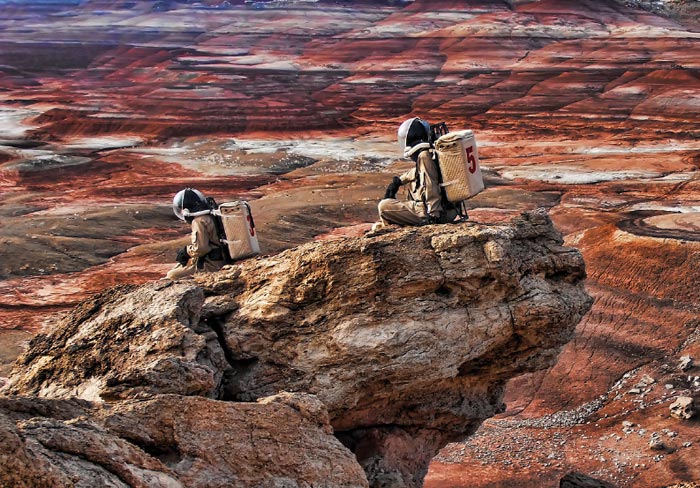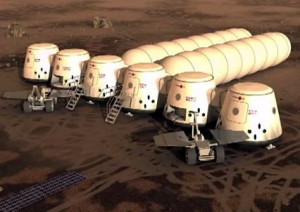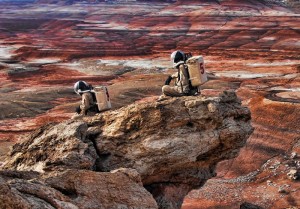The Mars One project outlined a revised roadmap this week providing details on how the enterprise will unfold. Here is a quick summary:
2013 – start of the crew selection process with over 70,000 applying for the initial 4 spots;
2015 – after applicants are narrowed down training starts (it will be continuous to 2022) at two sites on Earth (one in a desert location, the other in an arctic environment) that will simulate the Mars One settlement;
2016 – demonstration launch to Mars of a lander to prove the technology’s viability, as well as launch of a communication satellite with 4 times the data bandwidth of the current NASA Mars Reconnaissance Orbiter providing a 24/7 link between the two planets;
2018 – the search for the colony site begins with launch of a rover with accompanying trailer for use later in moving modules to the colony site. The rover will have tools on board for preparing the site as well;
2018 – launch of a second communication satellite placed in an L5 Lagrange position to ensure continuous communication between Earth and Mars even when the Sun gets between the two planets;
2020 – six missions will deliver two living modules, two life support systems and two supply units guided by the rover to the colony site;
2021 – six additional cargo units will land on Mars and will be transported and assembled at the colony site with life support systems fully connected, extraction systems for producing oxygen and water deployed and operational, nitrogen and argon extraction system become operational and habitats including inflatables shielded by rovers excavating and depositing Martian soil as cover;
2022 – Mars One transit vehicle launched into low-Earth orbit followed by transit habitat and Mars lander. Assembly crew puts the spaceship together. Two additional propellant stages are launched and connected and finally the first crew is transported to the completed ship and then launched on a 210-day voyage to the planet;
2023 – Mars One crew reaches the vicinity of Mars and enters Mars Lander for descent to the planet. The crew remains in the Lander for two days to adjust to Martian gravity, then deploys Mars space suits to leave it. The rover provides transport to the settlement which is entered through the installed airlock. Mars One crew then gets to work completing deployment of the solar arrays, hooking up the living modules and setting up food production;
2023 – additional cargo units for the second mission arrive and are picked up and installed by the crew to establish redundancy and prepare for an expanded settlement. Redundancy designed to sustain a crew of up to 16 settlers;
2024 – the second Mars One crew begins a journey to Mars on a 240-day trajectory arriving in 2025;
2025 – additional cargo units to support a third mission arrive on Mars where the 8 settlers will prepare the colony for the next group to arrive;
2026 – the third Mars One crew will begin its journey to the planet to be followed by additional settlers every two years thereafter.
Is the Mars One roadmap viable? According to Robert Zubrin, President and Founder of the Mars Society, a non-profit organization that has advocated the human exploration and settlement of Mars, the Red Planet has a wealth of resources that can be exploited by human and robotic crews. For example, in equatorial regions, where temperatures are more benign, the soil of Mars contains 5% water. In polar regions that number rises to 60%. That means there is plenty of water from which to extract oxygen for breathing. The water can also be a source of hydrogen for fuel. And of course it can be used to irrigate plants which certainly will have the CO2 they need considering the Martian atmosphere, although tenuous, is largely composed of that gas.
The equator on Mars gets sunlight equivalent to that which Norway receives here on Earth. Plants that grow in Norway in natural light, therefore, should be able grow on Mars. Mars also has nitrogen in abundance which can be used for fertilizer. Other resources that make Mars viable for humans includes a motherlode of raw materials from which to fabricate infrastructure. This includes the water and CO2 which can be used to make plastic, and iron oxides and silicon oxides for iron, steel and glass.
As we have seen from the performance of Spirit and Opportunity, the two Martian rovers that preceded Curiosity, the photovoltaics developed here on Earth work reasonably well on Mars. Improved solar cell efficiency and solar concentrators make sense for Mars. The resources to build and maintain fuel cells is readily available there as well. And evidence of a subsurface water table means the planet generates geothermal heat which will likely be exploited very quickly by any human Martian habitation.
So once we get our first humans on Mars there is no immediate challenge that Mars One cannot overcome. That is not the case however when we talk about getting the infrastructure to Mars so that there is a place for humans to go to when they arrive. From our history of Martian exploration getting to the planet has been fraught with failure. More than half of the spacecraft we have sent to the Red Planet have ended up in mission failure. One missed milestone in the Mars One project and it will be set back for months if not years.
Mars is a long way to go to build our first off world space colony. The trip today takes six months. We have yet to develop the technology to shorten the time frame. And humans have only experienced low-Earth habitation so far where distances are short and the margin of safety far greater than any voyage to Mars. And our only extra-planetary experiences involving humans so far have taken us to the Moon, where our visits were short term. Yet the Moon contains many similar resources to those found on Mars including water. So one would think if we are to establish a Solar System colony anywhere that the Moon would be the place we go first.











